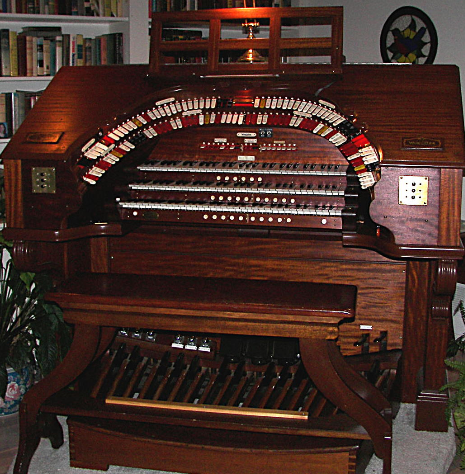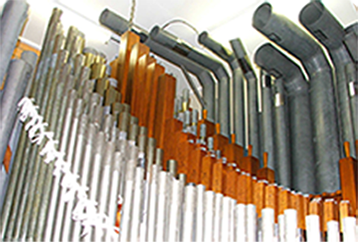
Six important things distinguish a theatre pipe organ from a classical or church organ. Most of these differences are attributed to Robert Hope-Jones, the father of the Theatre Pipe Organ. They are:
- Unification and extension of pipe ranks.
- Exclusive use of electric (or electro-pneumatic) action.
- Higher wind pressures.
- The use of “tremulants”.
- Tuned percussions, and the “toy counter” (untuned percussions, and sound effects).
- The horseshoe shaped console utilizing stop tablets, rather than draw knobs.
Unification and extension gives the theatre organ its unique flexibility. As described in a previous article on “Number of pipes in a rank”, theatre organ ranks are extended by adding pipes above and below unison pitch. A rank of 61 pipes at unison pitch with 12 added pipes at the low end of the scale and 12 more at the high end of the scale (a total of 85 pipes) enables a theatre organist to play THREE stops at 16’, 8’, and 4’ pitches from ONE rank of pipes. A non-unified classically designed organ, utilizes THREE "straight" ranks of 61 pipes each or 183 pipes to accomplish the same thing!
Unification also makes it possible to have the same stop available at ANY keyboard and/or the pedals, each stop tab playing the same rank independently.
This, along with the use of the same rank for stops at several pitches, is why a theatre organ console has many more stop tabs than ranks. The organ designer can specify the stop at several pitches wherever desired on the keyboards/pedal once the extended rank is included in the organ.
In a traditional church organ, a rank of pipes is playable ONLY from ONE manual or the pedals, or from more than one manual via inter-manual couplers. With their excellent unification Theatre Pipe organs do not need to utilize inter-manual couplers, but some do offer them to provide additional flexibility.
Electro-pneumatic action was being tried by several organ builders around the turn of the 20th century. Hope-Jones’ design was very fast, and became the standard for the Wurlitzer company. Electro-pneumatic action is considered by many to be the single most significant contribution to the development of pipe organs. Previously, most pipe organs were operated by tracker actions, whereby the keys were PHYSICALLY CONNECTED to the pipe valves via wooden trackers. Electro-pneumatic action eliminated this by using wind pressure, controlled by electric solenoids, to operate the pipe valves, solenoids and pistons which control and operate the various stop tabs, keys and pedals on the console. The console was thus able to be physically detached from the organ! All signals from the console were transmitted by an electric cable to an electro-pneumatic relay, and from there to the pipes and effects in the organ chambers. Even this was cumbersome, however, as the cable connecting the console typically was huge containing hundreds of wires. Today’s modern computerized relay systems enable complete portability of consoles utilizing only a tiny wire connection from the console to the relay.
Higher wind pressures- Hope-Jones also demonstrated that higher wind pressures than used on church organs would allow pipes to more accurately imitate orchestral instruments. The higher pressure causes the pipes to produce harmonic overtones which, when mixed with other pipe ranks create the desired effect. He was influenced by the work of English Organ builder Willis, who was running his bigger reeds at higher pressures. Hope-Jones wanted as much power as possible to fill his organ venues, and applied the high pressure concept throughout the ranks of his instruments. High wind pressures enabled the development of ranks that are unique to theatre organs and allowed any rank in the organ to function as a solo instrument. The higher pressures were possible due to the advent of high-velocity, motor-driven blowers and wind regulators.
Tremulants - The addition of tremulants to the theatre organ (regular pulsations of air through the pipes causing a throbbing effect) gave the Theatre Organ “That great big beautiful sound which wraps itself all around you”, and is the most noticeable thing sonically to distinguish a Theatre Organ from a Church Organ.
Tuned percussions - Another distinction of theatre organs is the availability of tuned percussions. In keeping with the idea of a "unit orchestra," pneumatically and electrically operated orchestra tuned percussion instruments such as piano, xylophone, marimba, chimes, sleigh bells, chrysoglott and glockenspiel were attached to the organ, playable from the keyboards.
Toy counter- The addition of the “Toy counter” featuring non- tuned percussions or traps, such as drums, cymbals, tamborines, triangles, and wood blocks; and sound effects such as sirens, doorbells, train whistles and bird calls allowed the theatre organ to better accompany silent movies.

A Toy Counter featuring drums, cymbals, tamborine, triangle, doorbell, sirens, etc.
Horseshoe console - The final thing which distinguishes theatre pipe organs from classical instruments is the design of the console. A traditional organ console was not adequate to encompass all the stops on a theatre organ since the large number of draw knobs required would make the console so huge as to be unmanageable by the organist. Thus, the horseshoe console was born. Based on a curved French console design, and using stop tablet switches or "tabs" instead of drawknobs, the horseshoe console now allowed the organist to reach any stop or control while playing any piece of music. The smaller stop tabs permitted the addition of many more stops along the curve of the horseshoe than could be accommodated on a traditional console.










